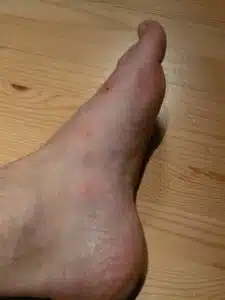Every day we are asked “how do I get rid of *fill in the blank*?” We thought it would be useful to write a post on the most common pests we are asked about. This month we look at chiggers and fleas.
How do I get rid of chiggers?
Chiggers come from the mite family and are also known as berry bugs and harvest mites, to name a few. They are microscopic in size (1/60th of an inch) and are actually a relative of the tick. In their larval stage they attach to animals (us included) and feed. They don’t bite, but instead inject digestive enzymes that break down skin cells. After feeding they drop to the ground, leaving behind an irritated and itchy lesion. The itch only occurs after they drop off.
Chiggers can be found anywhere, but they gravitate to dense vegetation and are at their peak in early summer. In Texas, they are a problem for far longer than the northern states. You can’t do much for the itch except calamine, hydro-cortisone and other topical options.
Prevention is in two parts. Firstly, minimize your contact with chiggers by wearing tall socks (a stylish look in the summer) and tightly fitting clothing. An insect spray containing DEET will help ward them off.
Secondly, in your own yard you can reduce their numbers by cleaning up. Overgrown weeds and shrubs, tall grass, twig piles and leaf litter. The less home they have the better. Mosquito Joe can treat your grass on a cycle to dramatically reduce the numbers, so feel free to give us a call for more information.
How do I get rid of fleas?
The flea is no joke and getting rid of them is no joke either. Fleas consume blood to live and they are not picky on whose blood they drink. The easiest way to determine if you have a flea issue in your home or yard is to either walk around in some white socks and take a close look, or you can lay some white paper in your yard and check it in a few minutes.
Fleas are about 3mm long and are easiest to spot by their jumping – they can leap 7 inches and are considered the second-best jumper in the world. They have a rapid life cycle and no one has determined how to kill them in their larval stage. There is also no way to kill them in egg form, and considering the average female lays several thousand in her lifetime (2-3 months) it is easy to see why they are so hard to manage. Whatever pest control option you opt for, it is ESSENTIAL that you repeat it several times in order to gain control.
In Texas, particularly in the country, controlling fleas in your yard is very difficult. While you may have a fence, a mouse, rat, deer or other wildlife can bring them in. A good rule of thumb for fleas is if you see one you have many and they will be everywhere.
There are a number of home remedies banded about on the internet. It’s safe to say they all sound good and all work badly. If you have pets it is imperative that you treat them. Otherwise they will shuttle your fleas back and forth for you. You must treat both the inside and the outside of your home. You can bomb inside and then vacuum (cleaning out the bags as soon as you have finished to get rid of the eggs). Repeat this several times over a week to kill the larvae and eggs you could not kill. For the outside you really do need a pest control company and we don’t say this to sell ourselves. Our customers who have flea treatments receive them on a regular cycle so we can gain control and maintain control over the population. Fleas will gravitate to shady areas that are cool and sandy, so again year clean-up is important.
Next month we will tackle fruit flies, bed bugs and fire ants.
Searching through dozens of home and commercial service providers is a thing of the past. Rely on Neighborly’s national network of trusted, local service professionals for all your home and commercial service needs.





 App Store
App Store
 Google Play Store
Google Play Store